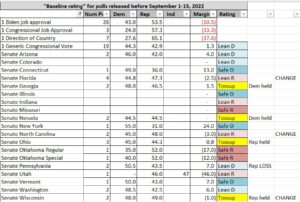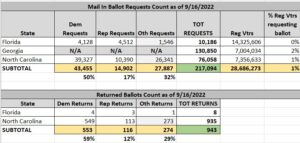Now that every state but Louisiana has held its primary (Louisiana’s primary is on the same day as the national general election on November 8), election season is officially underway. Before looking at House and/or Governors races, JMC wanted to “get current” with Senate race polling.
Scorecard Criteria
Publicly available polling data for all Senate races has been compiled for the first 15 days of September (when people ARE starting to focus on elections), and since we already have a baseline (which was posted here), we now can spot any trends occurring across the country. As polling data is compiled for a given time period (which in this case is September 1-15), it is then averaged for each Senate race, and with the average poll showing for each candidate, here’s how JMC rates each race:
(1) Safe Democratic/Republican – A candidate either has a polling average of at least 50% and/or at least a 10-point lead in the polls;
(2) Lean Democratic/Republican – A candidate has a 3-9 point lead in the polls;
(3) Tossup – A candidate’s lead is less than 3 points in the polls;
JMC’s 9/16 Scorecard
Given those criteria, this is the “state of the US Senate” as of the writing of this article (and based on September 1-15 polling data):
Aggregate Dashboard statistics
- Biden job approval: 54-43% Disapprove (no change since 9/12)
- Congressional job approval: 57-24% Disapprove (was 56-21% disapprove)
- Generic congressional vote: 44-43% Democratic/Republican (was 46-44% Democratic)
- Direction of country: 65-28% wrong direction (was 67-26% wrong direction)
Senate race statistics
- Current: 50 Democrats, 50 Republicans
- Polling average: 49 Democrats, 47 Republicans, 4 Tossups (2 Republican seats, 2 Democratic seats) (was 50-45 Democratic)
- Net pickup: +1 Democrats (was +2 Democrats)
Commentary: The polling baseline published earlier this week showed Republicans losing two seats (Wisconsin and Pennsylvania), and 5 seats’ being a tossup. JMC has (based on September 1-15 polling data) made the following three ratings changes that marginally benefit Republicans:
- Florida Senate from “Tossup” to “Leans Republican” – Senator Marco Rubio has moved from being tied in the polls to 2.5 points ahead – the bare minimum for the cutoff to take a race out of “Tossup”;
- North Carolina Senate from “Tossup” to “Leans Republican” (this is an open seat held by a Republican), as the Republican candidate went from being behind 0.5 points to leading by 3 points – enough to take a race out of “Tossup”;
- Wisconsin Senate from “Leans Democratic” to “Tossup” – Senator Ron Johnson has moved from being down 3 points in the polls to being up 1 point. Particularly telling were the two Marquette polls released on August 17 and September 14, which showed Senator Johnson moving from a 7-point deficit (44-51%) to a one-point (49-48%) lead;
- Republicans have also seen favorable movement in two more contests, but not enough for the “scorecard rating” to be changed – yet:
- In Arizona, a 6-point Democratic lead for Senator Kelly has narrowed to 4 points;
- In Nevada, a 2-point Democratic lead for Senator Cortez-Masto is now a tied race;
- In two other Senate contests, there has been some movement to the Democrats, but in each case, that “movement” was due to a single outlier poll:
- In Georgia, Senator Raphael Warnock went from trailing 46-47% to leading 48-47%. However, a single poll from Quinnipiac showed Warnock ahead 52-46%. When examining polling they released in early November 2018 (polls released in the last week of the previous midterm are a good way of evaluating prior pollster performance), they showed Democrats up 7 points in both the Governor and the Senate races in Florida – races Republicans narrowly WON. Given the size of that polling miss, if we remove this one outlier poll, the only other poll released since September 1 shows Herschel Walker up 47-44%;
- In Ohio (an open seat held by a Republican), the Republican candidate went from a 2-point lead to a 1-point polling deficit, solely due to a Center Street PAC poll showing the Democrat up 48-39%. Without this poll included, the Republican remains ahead by 2 points.
It’s also worth emphasizing is that this is the first “scorecard” for polling data that REALLY counts – polls released starting in early September. As of the writing of this article, we’re missing data on one potentially competitive race: the New Hampshire Senate race (this is a Democratic held seat in a swingy state), but in fairness to New Hampshire, it JUST concluded its primary election three days ago.
Overall, the polling results for the first two weeks of September show a slight and consistent “reddening.” Will this trend continue ? We will revisit this topic in a couple of weeks.
Early voting
While it is true that Election Day isn’t until November 8, voting has already begun in several states. North Carolina sent out its mail ballots a week ago (as did a handful of counties in Florida), while Georgia is accepting mail in ballot requests. As of the writing of this article, here’s where we stand both with mail ballot requests and actual voted mail ballots:
- Mail ballot requests (FL, GA, NC): 217,094
- Returned mail ballots (FL, NC): 943
While people are already requesting ballots and/or voting, the “election cycle” is about to accelerate in upcoming days, when between September 19 and 29, seven states will start n person early voting.
Why do these numbers matter ? As mentioned in this analysis, 72% of the vote was cast before Election Day, and even considering that some of that was caused by the pandemic’s changing voting behavior (whether voluntarily or by government decree), JMC believes that there has been a permanent shift to some extent of people wanting to “get it over with” and vote before Election Day. This mindset WILL affect when people are making up their mind about who to vote for, and both candidates/consultants would be wise to take this new paradigm into consideration when planning their messaging/get out the vote efforts.
Conclusion
Now that we have both polling and early voting data to track, we will be getting a steadily clearer picture of the midterm elections in upcoming weeks.


